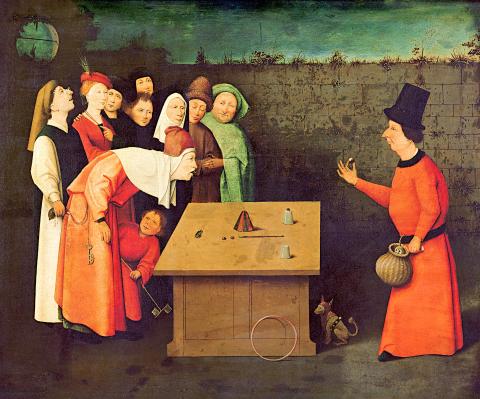Chinese Practice
無中生有
(wu2 zhong1 sheng1 you3)

Photo: Wikimedia Commons
照片:維基共享資源
create something from nothing
前幾週「活用成語」單元,我們介紹了三個出自「三十六計」的成語:「釜底抽薪」、「渾水摸魚」和「三十六計,走為上策」。這次要介紹成語是「無中生有」,屬三十六計中「敵戰計」的第一計,意思是「從無中創造出有」。此概念咸認出自道家經典,老子的《道德經》——第四十章寫道:「天下萬物生於有,有生於無」(世上所有東西都來源於某物﹝質﹞);而這某物是從虛無中所產生出來的)。然而,戰略上的「無中生有」和老子用以解釋事物起源的原意相去甚遠:「無中生有」的戰略是創造一種幻覺來欺騙敵人,讓他們誤以為有某些事物存在,或是反過來把有的說成沒有。比如在實際行動之前多次假裝進攻,等到後來敵方以為又是一次佯攻時,卻是真正的進攻,讓敵人猝不及防。
現今成語「無中生有」的用法通常含有否定的意義,意指本無其事,憑空捏造。意義相符的英文片語應為「plucked (or conjured) out of thin air」(憑空抓出(或召喚出)東西來)。這裡的動詞「to pluck」(抓出、拔出)是用手抓住並一下子快速移動,似乎是不假思索的動作;「thin」(稀薄)用於形容「air」(空氣)以強調其沒有實體;「conjure」(召喚)則是施魔法來創造。
另一片語「pull a rabbit out from the hat (or bag)」(把兔子從帽子(或袋子)中拉出來)也隱含有憑空召喚出事物的意思。像魔術師常用的把戲,在觀眾以為是空的帽子或袋子裡,抓出一隻活兔子來。這句話可以用來形容人能夠做出令人驚訝或出乎意料的事,而在最後關頭把問題解決。
最後,這種出其不意的情況在最後一刻出現而把問題給解決的情形,還可以用另一個片語來表示:「deus ex machina」。此為一古希臘術語的拉丁文翻譯,字面意為「來自機器的神」。它指古希臘戲劇的一種技巧,其運作的機制是用起重機(mechane)來把(扮演神的)演員放到舞台上。於是,棘手的情況經由這位神的干預,得以出乎意料地扭轉劣勢、轉危為安。今天,「deus ex machina」一詞仍被用來指寫作或電影中的情節手法──意料之外的事發生了,讓劇情急轉直下,令人很難信服,造成了劇評家所稱的「cop out」(理由牽強)的結局。
(台北時報林俐凱譯)
針對臉書流傳的那篇文章,部長予以駁斥,說該報導不僅未經事實查證,甚至無中生有、編造假新聞。
(The minister denied the allegations in the article shared on Facebook, saying that not only was there no evidence to support it, but that the story had been plucked out of thin air, and was fake news.)
藝術家在訪談中表示,創作的過程都很辛苦,有時得無中生有。
(During the interview, the artist relayed how difficult the creative process was, and how sometimes one had to just pull a rabbit out of the hat.)
英文練習
pluck out of thin air; pull a rabbit out of the hat; deus ex machina
In the past few weeks, Using Idioms has looked at three examples from the 36 Strategems, these being 釜底抽薪, 渾水摸魚 and 三十六計,走為上策. Another, this time the first of the “Enemy Dealing Stratagems” section, is 無中生有, meaning “creating something from nothing.” The concept is thought to derive from Chapter 40 of the ancient Chinese Taoist classic the Dao De Jing by Laozi, in which it is written 天下萬物生於有,有生於無 (All things on Earth are derived from something [substance]; this something sprang from nothingness). The strategic usage of 無中生有, however, is quite far removed from Laozi’s account of the origin of things: It deals more with the creation of an illusion to trick one’s enemy into thinking that something that is not actually there exists, or conversely that something that is there does not exist. One example might be to feign intention several times before actually carrying an action through, by which point the enemy is expecting a further feint, and has failed to prepare themselves for the attack.
In modern usage, 無中生有 is often used in a negative sense, to mean that something has been devised or fabricated with no basis in fact, or arrived at with no supporting evidence. A corresponding English phrase would be “plucked (or conjured) out of thin air.” Here, the verb “to pluck” means to grab or snatch with a single, rapid movement of the hand, as if giving the action little thought; “thin” is used to qualify “air” to emphasize its lack of substance; “conjure” means to create through the use of magic.
The idea of conjuring something up is also implicit in the phrase “pull a rabbit out of the hat (or bag),” a reference to the hackneyed magician’s trick of pulling a live rabbit out of a hat or bag previously assumed to be empty. It is used in situations where somebody is able to do something surprising or unexpected that enables them to solve a problem, usually at the very last minute.
Finally, this idea of the unexpected occurring at the last minute to resolve a situation is behind another phrase: deus ex machina. This is the Latin rendering of an ancient Greek term meaning, literally, “a god from the machinery.” It refers to the mechanics of a technique used in ancient Greek plays, where a crane (mechane) is used to place an actor (playing a deity) onto the stage. This deity might then perform an unexpected intervention in a tricky situation and save the day. Today, the term deus ex machina is still used to refer to a plot device in writing or movies where an unexpected intervention happens that stretches the credulity and provides what some critics of the device consider a “cop out” conclusion.
(Paul Cooper, Taipei Times)
Unless you can pull a rabbit out of the hat in the next two months, we’re going to go bankrupt.
(除非你有辦法在兩個月之內無中生有,不然我們就要破產了。)
Are you sure about those figures, or did you just pluck them out of thin air?
(你確定這些數字是對的嗎?還是說,這只是你憑空捏造的?)

Long before numerals and arithmetic systems developed, humans relied on tally marks to count. These simple, repeated marks — often just straight lines — are one of the earliest and most widespread methods of recording numbers. Archaeological findings suggest that humans began tallying in prehistoric times. During the Late Stone Age in Africa, humans began to carve notches onto bones to create tangible records of quantities. One of the earliest known examples is the Wolf bone, an artifact unearthed in Central Europe in 1937. This bone bears notches believed to be an early form of counting. Even more intriguing

A: In addition to Teng Kai-wei, Taiwanese infielder Cheng Tsung-che was called up temporarily to play for the Pittsburgh Pirates in early April. B: Yeah, Cheng is the 18th player in Taiwan’s baseball history to be moved up to the majors. A: Back in 2002, Chen Chin-feng became the first Taiwanese to play in the Major League Baseball (MLB), followed by Tsao Chin-hui, Wang Chien-ming, Kuo Hung-chih, Hu Chin-lung and Lin Che-hsuan. B: Those pioneers were later joined by Lo Chia-jen, C.C. Lee, Ni Fu-te, Chen Wei-yin, Wang Wei-chung, Hu Chih-wei, Tseng Jen-ho, Lin Tzu-wei, Huang Wei-chieh, Yu Chang,

When Nvidia CEO Jensen Huang revealed on Friday last week that the company is working with the Trump administration on a new computer chip designed for sale to China, it marked the latest chapter in a long-running debate over how the US should compete with China’s technological ambitions. The reasoning has sometimes changed — with US officials citing national security, human rights or purely economic competition — but the tool has been the same: export controls, or the threat of them. Nvidia believes it can eventually reap US$50 billion from artificial intelligence (AI) chip sales in China. But it so far has

Continued from yesterday(延續自昨日) https://www.taipeitimes.com/News/lang In many Western countries, the most common form of tally marks employs a five-bar gate structure: four vertical lines followed by a diagonal slash. To form this group, one begins by drawing four parallel vertical lines, each representing one. For the fifth, draw a diagonal line across the existing four. This diagonal stroke effectively creates a distinct group of five. To continue counting, just initiate a new cycle in the same manner. A set of five tallies combined with a single vertical line next to it represents the number six. Across many Asian countries, the Chinese character